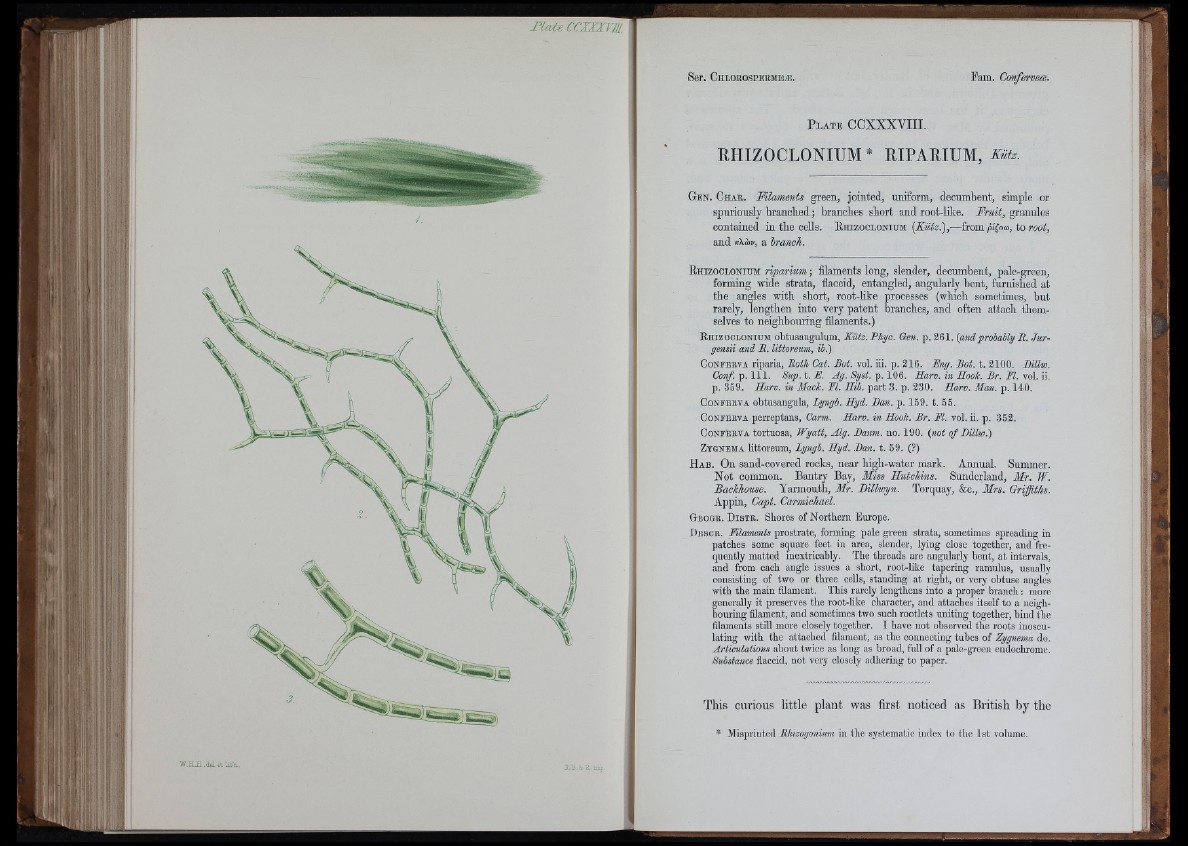
W.HH.Üet jfcL.
RHIZOCLONIUM * RIPARIUM, K ü tz .
G e n . Ch a e . Mlaments g re en , jo in te d , im ifo rm , d e cum b en t, simple or
sp u rio u s ly b r a n c h e d ; b ran ch e s s h o rt a n d ro o t-lik e . g ran u le s
c o n ta in ed in th e cells. E hizoclonium {Kiitz.),-—from piioa, to root,
a n d ¿k!bv, a i
E hizoc lonium riparium ; filaments long, slender, decumbent, pale-green,
forming wide strata, flaccid, entangled, angularly bent, furnished at
the angles with short, root-hke processes (which sometimes, but
rarely, lengthen into very patent branches, and often attach themselves
to neighbouring filaments.)
E h iz o c l o n iu m obtusangulum, Kiitz. Phyc. Gen. p. 261. {andprobably R. Jur-
gensii and R. littoreum, ib.)
C o n pe ev a riparia, Roth Cat. Bot. vol. iii. p. 216. Kng. Bot. t. 2100. Billw.
Conf. p. 111. Sup. t. K. Ag. Syst. p. 106. Harv. in Hook. Br. M. vol. ii.
p. 359. Harv. in Mack. M. Hib. part 3. p. 230. Harv. Man. p. 140.
Conpeeva obtusangula, Lyngb. Hyd. Ban. p. 159. t. 55.
C o n pe ev a perreptans, Carm. Harv. in Hook. Br. M. vol. ii. p. 352.
Conpeeva tortuosa, Wyatt, Alg. Banm. no. 190. {not o f Billw.)
Zy g n em a littoreum, lyngb. Hyd. Ban. t. 59. (?)
H a b . On sand-covered rooks, near high-water mark. Annual. Summer.
Not common. Bantry Bay, Miss Hutchins. Sunderland, M r. W.
Backhouse. Yarmouth, Mr. B illw yn . Torquay, &c., Mrs. Griffiths.
Appin, Capt. Carmichael.
G e o g e . D i s t e . Shores of Northern Europe.
D e s c r . Filaments prostrate, forming pale green strata, sometimes spreading in
patches some square feet in area, slender, lying close together, and frequently
matted inextricably. The tlireads are angularly bent, at intervals,
and from each angle issues a short, root-like tapering ramulus, usually
consisting of two or three ceUs, standing at right, or very obtuse angles
with the main filament. This rarely lengthens into a proper branch : more
generally it preserves the root-like character, and attaches itself to a neighbouring
filament, and sometimes two such rootlets uniting together, bind the
filaments still more closely together. I have not observed the roots inosculating
with the attached filament, as the connecting tubes of Zygnema do.
Articulations about twice as long as broad, full of a pale-green endochrome.
Î flaccid, not very closely adhering to paper.
This curious little plant was first noticed as British by the
* Misprinted Rhizogozikm iu the systematic index to the 1st volume.